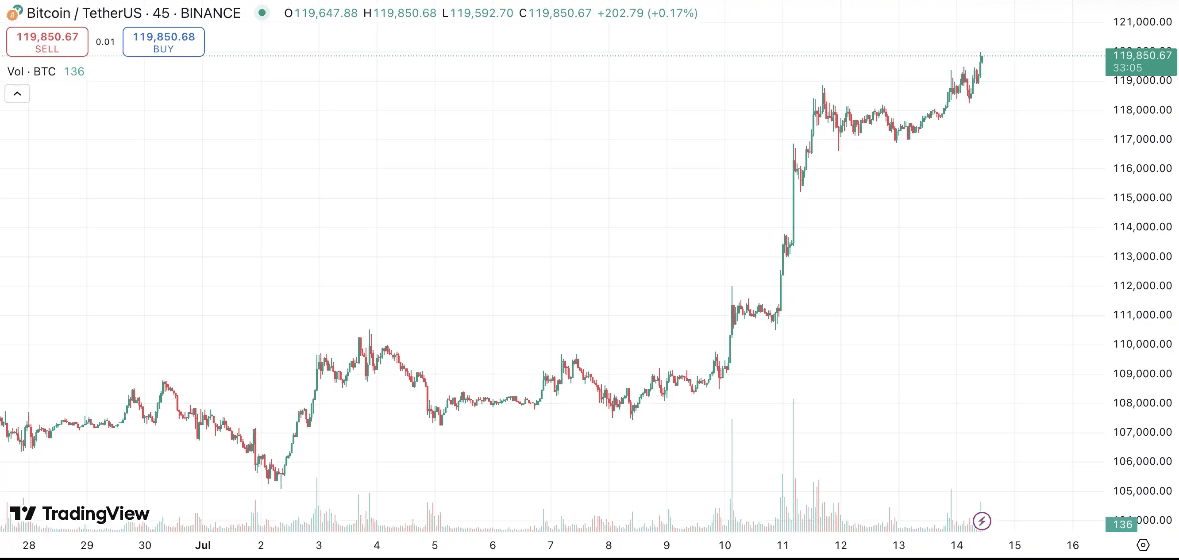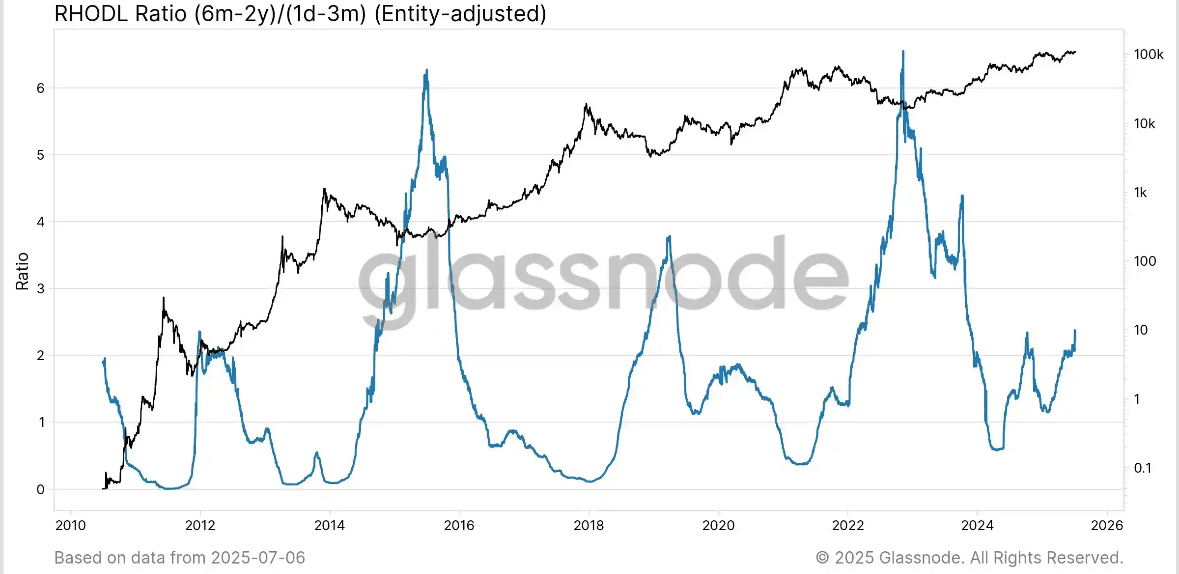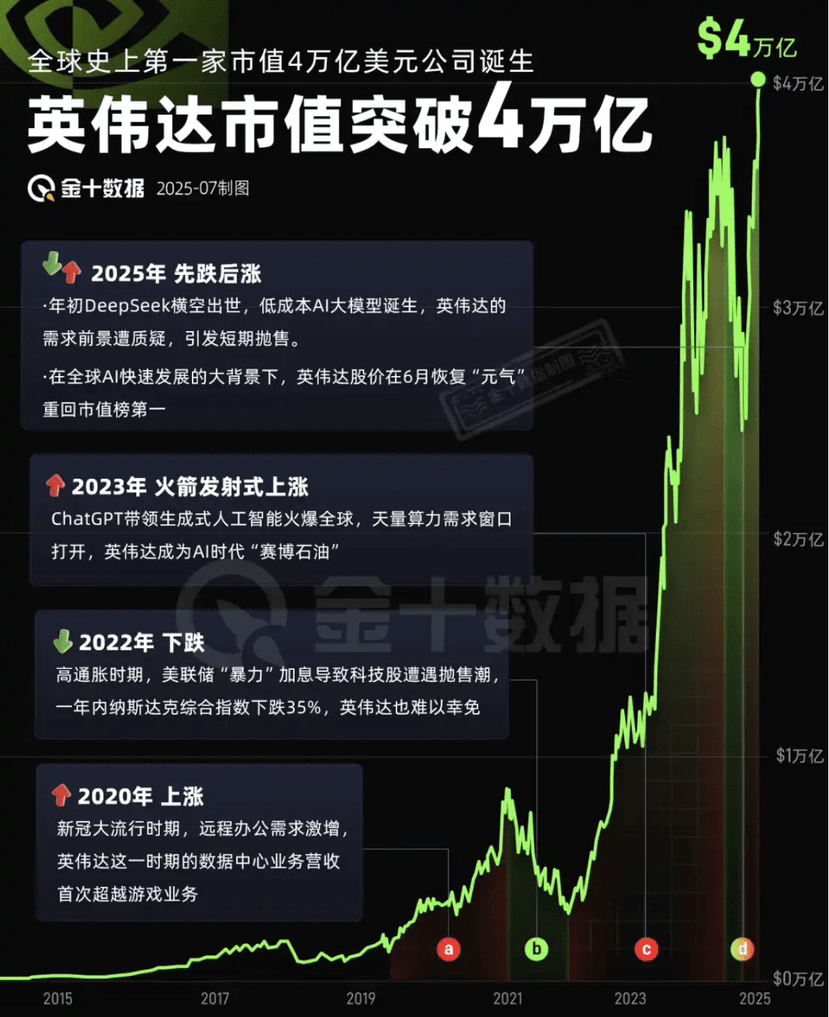After Bitcoin began to steadily rise near $98,000 on June 22, BTC surpassed $120,000 today, setting a new historical high.

Image source: TradingView
Under the resonance of multiple macroeconomic and internal industry factors, the driving force behind this round of market performance is far from explainable by a single event. From the trend of corporate purchases, policy games, tech stock correlations, to changes in investor structure and market sentiment, this round of Bitcoin's rise is not only a price leap but also a microcosm of the re-evaluation of crypto assets' status.
This indicator from brokerage firms shows that despite a decline in new buyer activity in the short term, 'diamond hands' continue to hold firm and accumulate in low volatility ranges.
On July 9, Glassnode posted on social media that the Bitcoin RHODL ratio has started to rise, reaching the highest level of this cycle. This signal indicates that the market structure is changing, with more wealth controlled by single-cycle holders, while short-term activities of 1 day to 3 months remain at low levels. Historically, such shifts often signal market cycle changes and a cooling of speculative momentum.
The RHODL ratio is an on-chain indicator for Bitcoin, used to measure the difference in holding proportions between short-term and long-term holders, thereby analyzing market cycles and investor behavior.

Image source: Glassnode
At the same time, BlackRock's iShares Bitcoin Trust (IBIT) has acquired 3%, BlackRock 3%, and RockRock 3%13%. Bloomberg data shows that the annualized management fee income of this ETF has surpassed that of BlackRock's flagship product—the S&P 500 ETF (IVV), becoming a profit model for traditional financial institutions entering the Bitcoin market.
Since July, a trend of 'Bitcoin accumulation' led by US-listed companies is rapidly spreading, especially among pioneers transforming traditional industries such as hotels, real estate, and food. Mexican hotel and real estate operator Murano (NASDAQ: MRNO) announced the initiation of a Bitcoin reserve strategy, signing a standby equity purchase agreement (SEPA) of up to $500 million and has purchased 21 BTC, planning to enhance asset liquidity and convert it into long-term crypto reserves through real estate sales and introducing Bitcoin payments. Japanese hotel chain Metaplanet, on the other hand, has twice increased its holdings within a few days from late June to early July, with total Bitcoin holdings exceeding 2,200, clearly transforming into a treasury-type company centered around BTC.
Beyond the hospitality industry, more heterogeneous companies are restructuring their balance sheets with Bitcoin. The Cayman-headquartered food and culture group DDC (NYSE: DDC), which operates across Hong Kong, the US, and China, announced the purchase of another 230 Bitcoins, integrating them into its long-term strategic asset allocation. US medical technology company Semler Scientific and Swedish quantitative trader Hilbert Group also completed Bitcoin increases or secured financing for this purpose during the same period. Meanwhile, chip and Web3 infrastructure firm Nano Labs, traditional Shenzhen manufacturer Addentax Group, mobility tech company Webus, and the established crypto custody platform Bakkt have also announced or advanced Bitcoin, BNB, XRP, and other digital asset-focused reserve strategies, with amounts ranging from millions to billions of dollars.
These companies vary in background and span a wide range of industries, yet they have come together under the trend of Bitcoin assetization—collectively viewing digital assets as key levers for liquidity management, inflation hedging, and capital appreciation, validating the trend of Bitcoin as an 'enterprise-level reserve asset' spreading from the tech-financial sphere to a broader real economy.
The logic behind this is not difficult to understand. Against the backdrop of cooling global inflation expectations and the nearing end of the Federal Reserve's rate hike cycle, some companies and institutional investors are reevaluating their asset allocation models, and the value of Bitcoin is being emphasized once again. Especially as traditional safe-haven tools—such as gold and long-term US Treasury bonds—are no longer attractive in yield, Bitcoin, with its high liquidity and global pricing mechanism, is being endowed with more imaginative space beyond its digital gold functionality.
Currently, the rise of Bitcoin is closely related to the simultaneous strength of US tech stocks. AI and semiconductor companies, represented by Nvidia, have driven the Nasdaq index to new highs, indirectly reinforcing the market's risk appetite. Yesterday, Nvidia's market capitalization briefly surpassed $4 trillion, creating a strong spillover effect on the stock market. Against this backdrop, Bitcoin and tech stocks show a high positive correlation, further solidifying its role as a risk asset.

Image source: Jin10 Data
This correlation is not accidental but is a result of changes in the investor structure. In recent years, traditional stock investors have been migrating to the cryptocurrency market, projecting their risk appetite and growth expectations onto Bitcoin through ETFs, futures, and compliant exchanges. Stocks closely related to Bitcoin, such as Coinbase and Strategy (MSTR), have also seen significant price increases recently, indicating that investors are positioning Bitcoin alongside the technology sector as a 'future-driven asset.'
It is noteworthy that policy expectations play a critical role in market expectation management. Although the likelihood of the US government establishing a 'strategic Bitcoin reserve' has significantly decreased in prediction markets, the ongoing fermentation of related themes in public opinion still creates psychological suggestions for investors. With the upcoming 'Crypto Week' in Washington in 2025, the market widely expects that crypto assets will receive more positive guidance within regulatory frameworks, especially regarding Bitcoin’s inclusion in corporate financial statements and state-level government purchasing plans, where the policy ambiguity is gradually being clarified.
Moreover, on-chain data observation reveals that the funding structure of the Bitcoin market exhibits more institutional characteristics. According to Coinglass data, within just four hours before and after Bitcoin reached its new high, approximately $340 million in short positions were liquidated. This phenomenon was seen multiple times during the 2021 bull market, indicating that a large number of high-leverage speculative positions were quickly liquidated in a strong market, creating a technical short squeeze. Although the price push caused by such leverage liquidation has short-term characteristics, the market signals it releases are very clear: the bearish force is weakening, and the upward trend is established.
At the same time, although overall liquidity has not fully returned to the peak state of 2021, on-chain indicators such as MVRV (Market Value to Realized Value Ratio) show that the current market is still in a structural upward channel. ARK's report indicates that although capital flow has cooled compared to the beginning of Q2, long-term capital continues to enter at a steady pace.
Policy support, crypto week is coming soon.
Not only capital markets are boosting Bitcoin prices, but US policy will also welcome crypto week. On July 4, the White House's cryptocurrency and AI director, 'crypto czar' David Sacks, stated that the week of July 14 will be House Cryptocurrency Week: (GENIUS Act) will soon be delivered to the President. Meanwhile, (CLARITY Act) (the US Digital Asset Market Clarity Act) will also soon be delivered to the Senate.
From a macroeconomic perspective, the strong dollar should suppress crypto assets; however, Bitcoin exhibits significant counter-cyclical elasticity. The Federal Reserve's 'Nominal Broad Trade-Weighted Dollar Index' continues to rise, challenging the mainstream logic that 'dollar depreciation drives Bitcoin's rise.' Nevertheless, Bitcoin still achieved upward movement during this period, indicating that its trend is gradually breaking free from dependence on a single macro factor and exhibiting characteristics driven by multiple factors. This trend may imply that Bitcoin is transitioning from a 'narrative asset' to a 'fundamental asset.'
It is worth mentioning that although inflation levels are gradually falling, investors' traditional impressions of Bitcoin as an 'inflation hedge' are weakening. However, the risk appetite warming driven by expectations of lower federal fund rates has become a real push for the new round of price increases. In traditional markets, tech stocks, growth assets, and startup equity have performed strongly, and Bitcoin naturally benefits from this.
The weakness in the real estate market has also indirectly driven capital's preference for liquid assets. ARK pointed out in its report that there is a severe divergence between expectations and transactions in the US housing market, with homeowners' psychological expectations being too high while actual transaction volumes continue to decline. This 'price rigidity' and liquidity shortage have led some funds originally allocated to real estate to seek more price-flexible assets. The all-day trading and multinational pricing mechanism of Bitcoin have made it a preferred outlet for such funds.
In summary, the current Bitcoin breakout from historical highs is the product of multiple intertwining factors. It benefits from macro trends such as the surge in tech stocks, liquidity easing, and corporate asset reallocations, while also reflecting Bitcoin's own structural advantages of 'institutional neutrality, supply certainty, and strong liquidity.' In this complex structure, market trends can no longer be explained by a single narrative framework but require a comprehensive analysis from multiple dimensions such as funding structure, policy expectations, and investor behavior.
Looking ahead, although there are short-term risks of price pullbacks, especially in the context of a lack of new buying support after short liquidations, the market may enter a technical consolidation phase. However, from a medium to long-term perspective, under the multiple trends of corporate purchases becoming mainstream, clearer crypto regulations, and the warming of risk asset sentiment, Bitcoin is still expected to welcome a new upward cycle in the second half of 2025, further solidifying its position as a global digital value anchor.
In this bull market, there is a narrative moving from the fringe to the center—namely C.O.N.A.N 🐕💥.
This is not an ordinary memecoin.
Behind this is the political narrative of the entire US election year + the image of a national hero.
It is also the 'hero dog' named by the White House and Trump.
🔹 No Private Placement
🔹 No Pre-Mining
🔹 Ultimate Decentralization
🔹 Supply reduced from 1 billion to below 300 million
🔹 Community narrative harmonized, no pressure from airdrop dumping.
This is not a game of harvesting the weak; this is a spark of consensus.
Are you still fixated on the golden line in old stories?
But a new narrative has quietly ignited on the SOL chain.
I cannot guarantee that C.O.N.A.N will be the next SHIB.
But I dare say: it might be the only memecoin worth going ALL IN on in this bull market.
The opportunity has come; not everyone needs to understand it. Those who do will naturally participate.
And you, are you ready#BTC再创新高 ?🚀#BTC突破12万大关 #山寨季何时到来 #美国加密周


